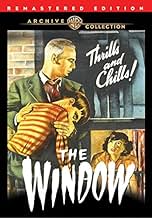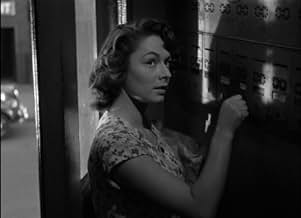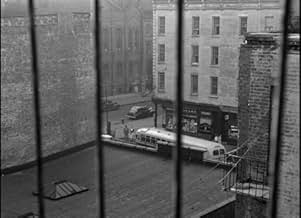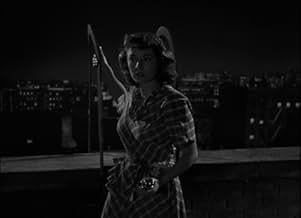Buddy, ne pouvant pas dormir dans sa chambre, s'installe pour la nuit sur le palier de l'escalier de secours à l'étage supérieur. À travers son sommeil, il aperçoit, chez les voisins du dess... Tout lireBuddy, ne pouvant pas dormir dans sa chambre, s'installe pour la nuit sur le palier de l'escalier de secours à l'étage supérieur. À travers son sommeil, il aperçoit, chez les voisins du dessus, un meurtre. Mais personne ne le croit..Buddy, ne pouvant pas dormir dans sa chambre, s'installe pour la nuit sur le palier de l'escalier de secours à l'étage supérieur. À travers son sommeil, il aperçoit, chez les voisins du dessus, un meurtre. Mais personne ne le croit..
- Réalisation
- Scénario
- Casting principal
- Nommé pour 1 Oscar
- 5 victoires et 3 nominations au total
- Murdered Seaman
- (non crédité)
- Cop Carrying Stretcher
- (non crédité)
- Police Officer
- (non crédité)
- Police Officer
- (non crédité)
- Police Officer
- (non crédité)
- Police Officer
- (non crédité)
- Observer at Scene
- (non crédité)
- Police Officer
- (non crédité)
- Stranger on Street
- (non crédité)
- Police Officer
- (non crédité)
- Detective Ross
- (non crédité)
Avis à la une
Seeing this taut little thriller in a small western town when I was 10 not only scared the heck out of me, but influenced my perception of urban life for years to come. Seeing the film again 60 years later, I'm impressed with producer Dore Schary's insistence on the grimness of the tenements, at least by later suburban standards. There's no attempt to glamorize or even varnish the family's dingy, cramped flat. Whether on NY location or on an RKO sound stage, the lighting remains dark and oppressive. Of course, that not only heightens the noirish atmosphere, but also lends an uncommon degree of realism to the family's working- class environment. After all, Dad works the nightshift, while Mom helps with the extended family, leaving little Tommy home alone. And that, I believe, amounts to more than just a handy plot device. And get a load of the on-location ruins where the kids play at the beginning—looks like something out of post-war Europe. No wonder MGM went after Schary in an effort to become more socially relevant in post-Andy Hardy America. There may be a lot of Hollywood in the melodrama itself, but the look and feel is definitely not Hollywood of the time. What a fine little film that's still edge-of-the-seat excitement. And, if I recall correctly, I was an especially good little boy for a long time afterward.
It's a bit jarring to see Della Street as a gritty Manhattan housewife with a coarse blue-collar husband, but it's also a lot of fun and she looks terrific. Barbara Hale is still alive as I write this, amazingly, and will turn 91 in a few weeks. At the film festival, this film was introduced by someone who had telephoned Barbara Hale and asked her for her memories of making this movie. She said the movie was supposed to take place in the summer, so the actors dressed very lightly, but it was really filmed in a much colder time of year and she remembers freezing as they shot scene after scene. Could have fooled me, the movie comes across as summery and hot with lots of sweat.
Every detail fascinated me, especially of apartment life in the 1940s: tiny rooms, closet-sized bathrooms with dwarf sinks, and kitchens that looked like airplane galleys. Dark and sinister stairwells up to dingy apartments, fire escapes and alleys, cigarettes galore, and black telephones like my grandmother used to have. Every scene is richly textured, almost as if the director knew that audiences of the distant future would be watching his movie and be mesmerized by the detailed scenery, from the local police station to the pay phone at the corner drugstore.
Others have reviewed the plot and I have nothing much to add. But I will emphasize that the plot develops along paths that I would never have predicted, and the ending will rivet you to your seat. The conclusion was deeply satisfying and caused the audience to burst into whistles and applause. Hope this movie comes out on DVD quick... it's a treasure.
There are many tense scenes as Driscoll faces his nightmare all alone. The audience shares his fear as the killers have him next on their list. The acting is realistic as is the dialogue. The film also has eerie sections (eg, Ruth Roman outside Driscoll's window with a torch as he hides in his locked room) and dramatic moments (eg, when the killers kidnap Driscoll and put him in the back of a cab and they encounter a policeman). The strategy that Paul Stewart and Ruth Roman use to shut him up during the cab ride is genius. It's very funny and demonstrates perfect teamwork.
Children are usually annoying in films. Not here. A dramatic ending in a disused apartment block adds to the tension. Worth watching again. The way the movie is filmed and the location all add to the experience of a film that is actually quite scary in parts.
His parents (Arthur Kennedy and Barbara Hale) warned him he must stop his fantasies and what followed was a classic up-dating of the boy who cried 'wolf' once too often
One stifling night, the boy climbed out on to a fire escape to seek cool air and, through a crack under a window blind, he witnessed a murder
He knew no one would believe him although this time, for the first time, his story was true He tried to tell his mother that he had seen a couple called Kellerson trying to rob a drunk and killing him in a fight: the boy got scolded for his imagination and sent to bed His father locked him in for punishment; the boy escaped and took his story to the police station. A detective investigated, but could find no body, no signs of a struggle
Now the awful irony: the guilty Kellersons learn through the detective that the boy had seen them committing the crime, and the boy's parents, with terrifyingly understandable logic, send the boy to the killers to apologize 'for spreading such an awful story about them'.
The Kellersons cannot decide: should they leave well alone, as nobody believes the boy; or should they commit another crime to cover the first?
'The Window' is a classic little second feature, entertaining and suspenseful; unfortunately it had few successful imitators
Le saviez-vous
- AnecdotesThis film was shot in the latter part of 1947 but shelved by RKO boss Howard Hughes and released in 1949. When Bobby Driscoll got his Juvenile Oscar in 1950, he was 13 years old.
- Gaffes(at around 4 mins) While running down the top flight of stairs to play with the neighbor boys, Tommy's breath is visible. His breath is visible again (at around 25 mins) while he is running to the police station, just after he runs past the canopy of 136th. This is due to shooting in the late Fall when the movie is set in the 94 degree heat of summer.
- Citations
[last lines]
Tommy: [Tommy and his parents are in the back of a police car on the way to the police station] And that's all the truth.
Police Officer: That was some jump, son.
Tommy: Yeah, but I know one thing. I'm never gonna be a fireman. I don't like jumpin' in those nets.
Ed Woodry: I'm proud of you, Tommy. And from now on, I promise I'll believe you.
Tommy: I'm glad, Pop. And from now on, I promise I'll never make up another story.
Mary Woodry: That'll make us all happy.
Ed Woodry: I'll bet when we get down to the station, a lot of guys are going to point at me and say, "There goes Tommy Woodry's father."
[Tommy smiles and his father chuckles over a shot of his son's beaming face]
- Crédits fousThe role of "Tommy" played by BOBBY DRISCOLL by special arrangement with WALT DISNEY
- ConnexionsFeatured in Crumb (1994)
Meilleurs choix
Détails
- Date de sortie
- Pays d’origine
- Langue
- Aussi connu sous le nom de
- The Window
- Lieux de tournage
- Ville de New York, New York, États-Unis(abandoned tenements on 105th and 116th Streets)
- Société de production
- Voir plus de crédits d'entreprise sur IMDbPro
Box-office
- Budget
- 210 000 $US (estimé)
- Durée1 heure 13 minutes
- Couleur
- Rapport de forme
- 1.37 : 1
Contribuer à cette page





























